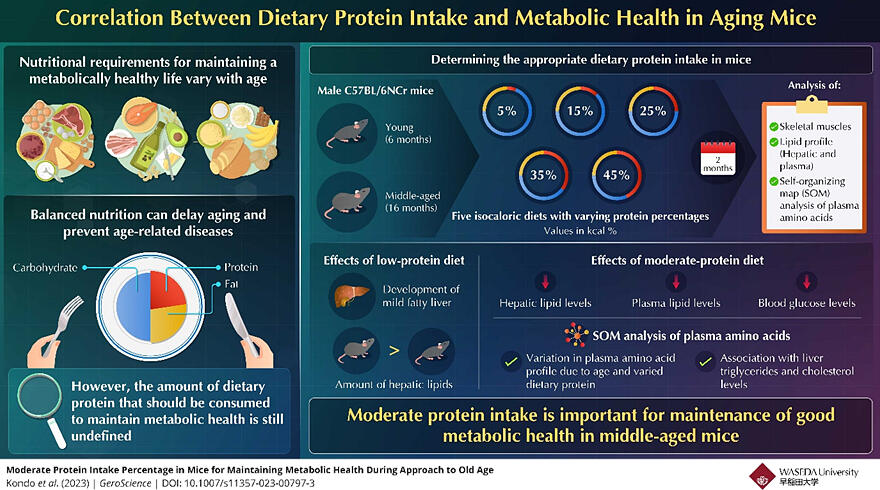A well‐balanced diet is the basis for healthy longevity. Based on the Food Balance Sheet (Approximate Figures) released by the Ministry of Agriculture, Forestry and Fisheries, the average daily calorie intake per person in Japan is 2271 kilocalories, and the contribution of protein, fat and carbohydrate intake to total calorie intake is 13.8%, 32.5% and 53.7%, respectively. What is the optimal macronutrient balance required for healthy longevity?
A research group led by Assistant Professor Yoshitaka Kondo of Waseda University and including Vice‐president Akihito Ishigami of the Tokyo Metropolitan Institute of Gerontology, Division Manager Hitoshi Aoki of the Research and Development Division, Nichirei Foods Inc., and Professor Shinichiro Takahashi of the University of Tokyo demonstrated that the optimal protein intake percent for staying healthy into old age is 25‐35%. It is expected that the study results will contribute greatly to staying healthy and achieving healthy longevity through dietary protein balance. The results were published online in GeroScience.

Provided by Waseda University
Recent research has shown that mice fed with low‐protein, low‐fat and high‐carbohydrate diets over their lifetime exhibit a longer lifespan. In contrast, it is recommended that older adults consume an adequate amount of protein to prevent or ameliorate the risks of sarcopenia and frailty due to undernutrition. As a result, the optimal macronutrient balance for healthy longevity may vary across life stages such as youth, middle‐aged and old age.
The research team conducted experiments with mice aiming to reveal the optimal protein intake percent for staying healthy into old age and maintaining healthy longevity.
In the experiments, young (6‐month‐old) and middle‐aged (16‐month‐old) male mice were fed diets with varying protein intake percentages (5%, 15%, 25%, 35% and 45% by calorie ratio), for two months—these groups and their diets were termed P5, P15, P25, P35 and P45, respectively— and the influence of the diets on health was examined according to the protein intake percent and age.
All the different diets contained a fixed 4.2 kilocalories per gram, and the fat percent was fixed at 25% to resemble the average Japanese diet. The carbohydrate percent in each of the diets was adjusted as follows: P5, 70%; P15, 60%; P25, 50%; P35, 40% and P45, 30%. The macronutrient composition of the P15 diet was the most similar to the current Japanese diet.
After two months of feeding, the body weights of the middle‐aged mice were higher than those of the young mice, and the body weights of the P5 group were lower than those of the other groups. Caloric intake was higher in the middle‐aged mice than in the young mice, and it was higher in the P5 group than in other groups and lower in the P45 group. The phenomenon where insufficient protein intake leads to greater food intake to provide more protein for physiological needs, or, conversely, when increased protein intake leads to a decrease in overall food intake, is known as "protein leverage".
The P5 group exhibited a high level of lipid droplets in the liver and high levels of hepatic triglyceride and total cholesterol. Compared to the young mice, the middle‐aged P5 and P15 groups had higher hepatic triglyceride levels. In contrast, both young and middle‐aged P35 groups did not show hepatic triglyceride accumulation.
In the young and middle‐aged mice, blood glucose levels were low in the P25 and P35 groups and high in the P45 group. Because the carbohydrate intake percent in the P45 group was low at 30%, amino acid degradation and subsequent gluconeogenesis may have occurred. No difference was observed in blood triglyceride levels based on dietary groups. However, blood total cholesterol levels were the highest in the P15 group and low in the P5, P35 and P45 groups.
To examine whether amino acid concentrations differ by diet with different protein intake percentages and by age, the research team subsequently measured blood concentrations of the 20 amino acids. Blood concentrations of nine essential amino acids, which cannot be synthesized in the body, showed no difference by diet or age. In contrast, blood concentrations of 11 non‐essential amino acids, which can be synthesized in the body, were highest in the P5 group and lowest in the P45 group in both young and middle‐aged mice. In the case of the P5 group, because dietary protein intake was insufficient, the body may have synthesized the non‐essential amino acids. Conversely, because the P45 group had insufficient dietary carbohydrate, the body may have degraded non‐essential amino acids and used them as energy source. Moreover, blood concentrations of branched‐chain amino acids (BCAA) were highest in the P35 and P45 groups. Because BCAAs are important amino acids for muscles, sufficient protein intake increases reserve strength.
Furthermore, the research team performed self‐organizing map (SOM) analysis (analysis by a machine learning approach) using blood amino acid concentrations. The analysis revealed formation of multiple clusters that consisted of mice with similar amino acid concentration profiles. The results showed that blood amino acid concentration profiles are determined by age and diets with different protein intake percentages. When a map of hepatic triglycerides was overlaid on the self‐organizing map, the P5, P15 and P45 groups with high hepatic triglyceride content clustered together, whereas the P35 group with low hepatic triglyceride content clustered together. These findings indicate that blood amino acid concentration profiles were associated with hepatic triglyceride levels.
This study revealed that an average protein intake of 25‐35% achieves the highest level of health in both young and middle‐aged mice. Although it is too early to apply these experimental findings to humans, increasing the current protein intake percentage of 13.8% in Japan to 25‐35% could be beneficial with regard to staying healthy into old age. The research team will further investigate optimal macronutrient balance for healthy longevity at each life stage, with the aim to prevent and improve sarcopenia, frailty and dementia.
This article has been translated by JST with permission from The Science News Ltd. (https://sci-news.co.jp/). Unauthorized reproduction of the article and photographs is prohibited.




